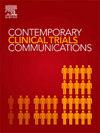在阿拉斯加土著家庭中对基于家庭的财政激励戒烟干预的可行性进行beta测试:Aniqsaaq(呼吸)研究的第二阶段
IF 1.4
Q4 MEDICINE, RESEARCH & EXPERIMENTAL
引用次数: 0
摘要
阿拉斯加州土著和美洲印第安人社区的商业吸烟率高得不成比例,并且在获得戒烟治疗方面面临障碍。我们测试了远程交付,ANAI家庭为基础的财务激励戒烟干预的可行性。方法我们在阿拉斯加招募了10对“二人组”(即一名吸烟的成年ANAI人[PWS]和一名他们选择的成年家庭成员),进行了为期6个月的文化定制干预(NCT05209451)。在六次吸烟状况检查期间,PWS在家中完成了过期的一氧化碳,唾液可替宁和自我报告的戒烟措施。两组成员都获得了越来越多的经济奖励,以确认PWS禁欲。参与者完成了基线和研究结束时的调查。结果10例PWS患者中8例为女性,平均年龄45岁(范围34 ~ 57岁),平均日吸烟13支(范围3 ~ 20支)。10名家庭成员中有5名是女性,4名目前也吸烟。在PWS参与者可能进行的60次检查中,41次(68%)完成;5人(50%)完成了所有签到。尽管PWS网络连接出现了小问题,测试工具丢失,付款收据延迟,但所有参与者都能够完成登记并收到所获得的付款。5名PWS在最后6个月的检查中戒酒,2名PWS在所有检查中都戒酒。5名PWS完成了研究结束时的调查;其中四人报告说这种干预是有帮助的,并会推荐给其他人。结论以家庭为基础的经济激励干预对ANAI家庭戒烟是可行的。接下来,将在全州范围内进行一项随机对照试验,以评估有效性并为未来的实施需求提供信息。本文章由计算机程序翻译,如有差异,请以英文原文为准。
Beta-testing the feasibility of a family-based financial incentives smoking cessation intervention with Alaska Native families: Phase 2 of the Aniqsaaq (to breathe) Study
Background
Alaska Native and American Indian (ANAI) communities in Alaska have disproportionately high commercial tobacco smoking rates and face barriers to accessing cessation treatment. We beta-tested the feasibility of a remotely delivered, ANAI family-based financial incentive cessation intervention.
Methods
We enrolled 10 “dyads” (i.e., one adult ANAI person who smokes [PWS] and one adult family member of their choice) across Alaska into a culturally tailored 6-month intervention (NCT05209451). PWS completed expired carbon monoxide, salivary cotinine, and self-reported abstinence measures at home during six smoking status check-ins. Both dyad members received financial incentives in escalating amounts for confirmed PWS abstinence. Participants completed baseline and end-of-study surveys.
Results
Eight of the 10 PWS were women, their average age was 45 years (range = 34–57), and mean daily cigarettes smoked was 13 (range = 3–20). Five of the 10 family members were women, and four currently also smoked. Of the 60 check-ins possible among PWS participants, 41 (68 %) were completed; five (50 %) completed all check-ins. Despite minor difficulties with PWS internet connection, lost test kits, and delayed payment receipt, all participants were able to complete check-ins and received payments earned. Five PWS were abstinent at the final 6-month check-in, and two PWS were abstinent at all check-ins. Five PWS completed the end-of-study survey; four reported the intervention was helpful and would recommend it to others.
Conclusion
A family-based financial incentive intervention for smoking cessation with ANAI families appears feasible. Next, a randomized controlled trial will be conducted statewide to evaluate effectiveness and inform future implementation needs.
求助全文
通过发布文献求助,成功后即可免费获取论文全文。
去求助
来源期刊

Contemporary Clinical Trials Communications
Pharmacology, Toxicology and Pharmaceutics-Pharmacology
CiteScore
2.70
自引率
6.70%
发文量
146
审稿时长
20 weeks
期刊介绍:
Contemporary Clinical Trials Communications is an international peer reviewed open access journal that publishes articles pertaining to all aspects of clinical trials, including, but not limited to, design, conduct, analysis, regulation and ethics. Manuscripts submitted should appeal to a readership drawn from a wide range of disciplines including medicine, life science, pharmaceutical science, biostatistics, epidemiology, computer science, management science, behavioral science, and bioethics. Contemporary Clinical Trials Communications is unique in that it is outside the confines of disease specifications, and it strives to increase the transparency of medical research and reduce publication bias by publishing scientifically valid original research findings irrespective of their perceived importance, significance or impact. Both randomized and non-randomized trials are within the scope of the Journal. Some common topics include trial design rationale and methods, operational methodologies and challenges, and positive and negative trial results. In addition to original research, the Journal also welcomes other types of communications including, but are not limited to, methodology reviews, perspectives and discussions. Through timely dissemination of advances in clinical trials, the goal of Contemporary Clinical Trials Communications is to serve as a platform to enhance the communication and collaboration within the global clinical trials community that ultimately advances this field of research for the benefit of patients.
 求助内容:
求助内容: 应助结果提醒方式:
应助结果提醒方式:


